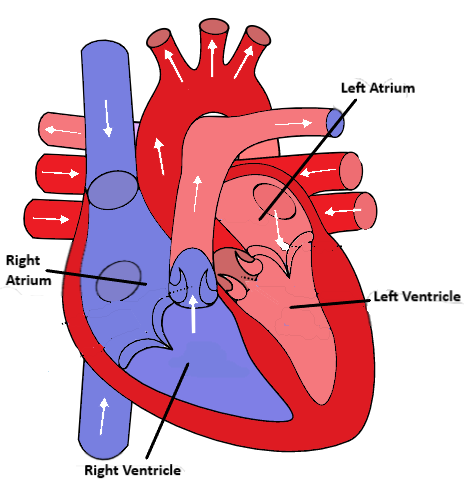
To avoid the mixing of the oxygenated and deoxygenated blood, the heart has how many chambers?
a. Four
b. Two
c. Three
d. Six
Answer
488.1k+ views
Hint: The human heart pumps blood throughout the body. Heart functions to transport nutrients, gases, and waste products around the body, to help the body maintain a constant body temperature, to protect the body from infection and blood loss. Also to help maintain fluid balance within the body.
Complete answer:
- The heart has four chambers. They are two atria and two ventricles.
- The oxygen-less blood from the body is received by the right atrium and it is pumped to the right ventricle. And then the right ventricle pumps the oxygen-less blood to the lungs.
- The oxygen-rich blood from the lungs is then received by the left atrium and is pumped to the left ventricle. The left ventricle pumps the oxygen-rich blood to the entire body.
- The one-way valves which are present in the heart prevent the backflow of blood, so, Oxygen-rich and carbon dioxide-rich blood cannot be mixed.

Hence, the correct answer is option (A).
Additional information:
- Two chambered hearts are found in fishes. The two chambers include an atrium and a ventricle.
- Three chambered hearts are found in Amphibians. The three chambers include two atria and a single ventricle.
- Six chambered hearts are not found.
Note: From the pulmonary vein, the left side of the heart receives oxygenated blood and pumps it into the aorta. From the vena cava, the right side of the heart receives deoxygenated blood and pumps it into the pulmonary vein. From the heart to the tissues, the arteries carry oxygenated blood away. Having the exception of pulmonary arteries, which carry blood to the lungs for oxygenation.
Complete answer:
- The heart has four chambers. They are two atria and two ventricles.
- The oxygen-less blood from the body is received by the right atrium and it is pumped to the right ventricle. And then the right ventricle pumps the oxygen-less blood to the lungs.
- The oxygen-rich blood from the lungs is then received by the left atrium and is pumped to the left ventricle. The left ventricle pumps the oxygen-rich blood to the entire body.
- The one-way valves which are present in the heart prevent the backflow of blood, so, Oxygen-rich and carbon dioxide-rich blood cannot be mixed.

Hence, the correct answer is option (A).
Additional information:
- Two chambered hearts are found in fishes. The two chambers include an atrium and a ventricle.
- Three chambered hearts are found in Amphibians. The three chambers include two atria and a single ventricle.
- Six chambered hearts are not found.
Note: From the pulmonary vein, the left side of the heart receives oxygenated blood and pumps it into the aorta. From the vena cava, the right side of the heart receives deoxygenated blood and pumps it into the pulmonary vein. From the heart to the tissues, the arteries carry oxygenated blood away. Having the exception of pulmonary arteries, which carry blood to the lungs for oxygenation.
Latest Vedantu courses for you
Grade 11 Science PCM | CBSE | SCHOOL | English
CBSE (2025-26)
School Full course for CBSE students
₹41,848 per year
EMI starts from ₹3,487.34 per month
Recently Updated Pages
Master Class 11 Economics: Engaging Questions & Answers for Success

Master Class 11 Business Studies: Engaging Questions & Answers for Success

Master Class 11 Accountancy: Engaging Questions & Answers for Success

Master Class 11 English: Engaging Questions & Answers for Success

Master Class 11 Computer Science: Engaging Questions & Answers for Success

Master Class 11 Maths: Engaging Questions & Answers for Success

Trending doubts
State and prove Bernoullis theorem class 11 physics CBSE

1 ton equals to A 100 kg B 1000 kg C 10 kg D 10000 class 11 physics CBSE

State the laws of reflection of light

One Metric ton is equal to kg A 10000 B 1000 C 100 class 11 physics CBSE

1 Quintal is equal to a 110 kg b 10 kg c 100kg d 1000 class 11 physics CBSE

Difference Between Prokaryotic Cells and Eukaryotic Cells




